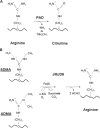Histone arginine methylations: their roles in chromatin dynamics and transcriptional regulation
- PMID: 19220199
- PMCID: PMC5433800
- DOI: 10.1042/BSR20080176
Histone arginine methylations: their roles in chromatin dynamics and transcriptional regulation
Abstract
PRMTs (protein arginine N-methyltransferases) specifically modify the arginine residues of key cellular and nuclear proteins as well as histone substrates. Like lysine methylation, transcriptional repression or activation is dependent upon the site and type of arginine methylation on histone tails. Recent discoveries imply that histone arginine methylation is an important modulator of dynamic chromatin regulation and transcriptional controls. However, under the shadow of lysine methylation, the roles of histone arginine methylation have been under-explored. The present review focuses on the roles of histone arginine methylation in the regulation of gene expression, and the interplays between histone arginine methylation, histone acetylation, lysine methylation and chromatin remodelling factors. In addition, we discuss the dynamic regulation of arginine methylation by arginine demethylases, and how dysregulation of PRMTs and their activities are linked to human diseases such as cancer.
Figures







Similar articles
-
Interplay between chromatin remodelers and protein arginine methyltransferases.J Cell Physiol. 2007 Nov;213(2):306-15. doi: 10.1002/jcp.21180. J Cell Physiol. 2007. PMID: 17708529 Review.
-
Histone arginine methylation and its dynamic regulation.Front Biosci. 2006 Jan 1;11:344-55. doi: 10.2741/1802. Front Biosci. 2006. PMID: 16146736 Review.
-
[Advances in histone methyltransferases and histone demethylases].Ai Zheng. 2008 Oct;27(10):1018-25. Ai Zheng. 2008. PMID: 18851779 Review. Chinese.
-
A role for CARM1-mediated histone H3 arginine methylation in protecting histone acetylation by releasing corepressors from chromatin.PLoS One. 2012;7(6):e34692. doi: 10.1371/journal.pone.0034692. Epub 2012 Jun 18. PLoS One. 2012. PMID: 22723830 Free PMC article.
-
The macromolecular complexes of histones affect protein arginine methyltransferase activities.J Biol Chem. 2021 Oct;297(4):101123. doi: 10.1016/j.jbc.2021.101123. Epub 2021 Sep 6. J Biol Chem. 2021. PMID: 34492270 Free PMC article.
Cited by
-
Transcriptional regulation of the human ferritin gene by coordinated regulation of Nrf2 and protein arginine methyltransferases PRMT1 and PRMT4.FASEB J. 2013 Sep;27(9):3763-74. doi: 10.1096/fj.12-226043. Epub 2013 May 22. FASEB J. 2013. PMID: 23699174 Free PMC article.
-
The histone- and PRMT5-associated protein COPR5 is required for myogenic differentiation.Cell Death Differ. 2012 May;19(5):900-8. doi: 10.1038/cdd.2011.193. Epub 2011 Dec 23. Cell Death Differ. 2012. PMID: 22193545 Free PMC article.
-
Protein arginine methyltransferase 5 (PRMT5) dysregulation in cancer.Oncotarget. 2018 Nov 30;9(94):36705-36718. doi: 10.18632/oncotarget.26404. eCollection 2018 Nov 30. Oncotarget. 2018. PMID: 30613353 Free PMC article. Review.
-
Epigenetic modifications of histones in cancer.Genome Biol. 2019 Nov 20;20(1):245. doi: 10.1186/s13059-019-1870-5. Genome Biol. 2019. PMID: 31747960 Free PMC article. Review.
-
Global analysis of protein arginine methylation.Cell Rep Methods. 2021 Jun 21;1(2):100016. doi: 10.1016/j.crmeth.2021.100016. eCollection 2021 Jun 21. Cell Rep Methods. 2021. PMID: 35475236 Free PMC article.
References
-
- Bedford MT, Richard S. Arginine methylation: an emerging regulator of protein function. Mol Cell. 2005;18:263–272. - PubMed
-
- Krause CD, Yang ZH, Kim YS, Lee JH, Cook JR, Pestka S. Protein arginine methyltransferases: evolution and assessment of their pharmacological and therapeutic potential. Pharmacol Ther. 2006;113:50–87. - PubMed
-
- McBride AE, Silver PA. State of the arg: protein methylation at arginine comes of age. Cell. 2001;106:5–8. - PubMed
-
- Cook JR, Lee JH, Yang ZH, Krause CD, Herth N, Hoffmann R, Pestka S. FBXO11/PRMT9 a new protein arginine methyltransferase, symmetrically dimethylates arginine residues. Biochem Biophys Res Commun. 2006;342:472–481. - PubMed
Publication types
MeSH terms
Substances
Grants and funding
LinkOut - more resources
Full Text Sources

